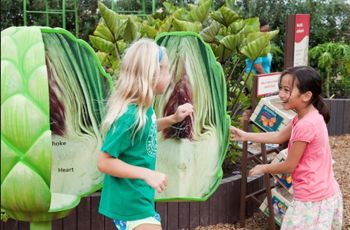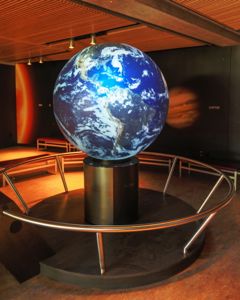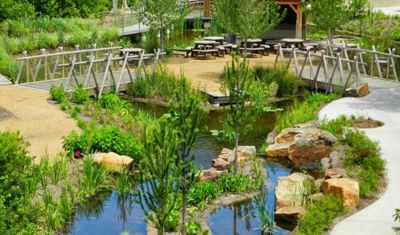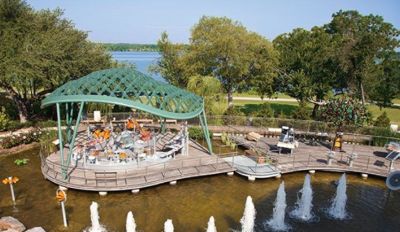
The Rory Meyers Children's Adventure Garden at the Dallas Arboretum opened in September. Photos courtesy of the Dallas Arboretum.
Nov. 19, 2013
A winding maze to wander, shiny cranks that can make water run uphill and flower pots the size of a small cottage. There’s a lot to play with and discover at the Rory Meyers Children’s Adventure Garden, whether you’re a toddler, teen or adult. But there’s much more to the 17 interactive galleries at the garden. There’s science blooming everywhere along with a strong commitment to protecting and preserving the earth.
 In the Incredible Edible Garden, fruit, vegetables and herbs look and smell enticing and help children learn where food comes from. It’s hard to care about eating good food if you’ve only seen produce on the shelves of the grocery or convenience store.
In the Incredible Edible Garden, fruit, vegetables and herbs look and smell enticing and help children learn where food comes from. It’s hard to care about eating good food if you’ve only seen produce on the shelves of the grocery or convenience store.
The Incredible Edible Garden.
Along with the myriad of plants and shrubs, trees are another important part of the Children’s Garden.
“Before the garden was developed, there were eight acres of bamboo where there is now a horticultural jewel,” says Dave Forehand, vice president of the garden and visitor services at the Arboretum.
In accordance with city of Dallas guidelines, an equal number of trees was planted for each one that was removed.
 At the heart of the garden is the Exploration Center. It’s one of the few buildings in the space and it hosts the most high tech portion of the garden. There are smart tables and time lapse videos to view and at the center is the OmniGlobe. This five-foot-tall sphere is the largest of its kind in Texas. It’s equipped with a touch screen that transforms the globe into models of plants, moons or our galaxy and displays geographically accurate views of continental drift, ocean currents, deforestation, evolving ecosystems and other scientific phenomena.
At the heart of the garden is the Exploration Center. It’s one of the few buildings in the space and it hosts the most high tech portion of the garden. There are smart tables and time lapse videos to view and at the center is the OmniGlobe. This five-foot-tall sphere is the largest of its kind in Texas. It’s equipped with a touch screen that transforms the globe into models of plants, moons or our galaxy and displays geographically accurate views of continental drift, ocean currents, deforestation, evolving ecosystems and other scientific phenomena.
The OmniGlobe.
Learning about patterns across the globe is just one more way to bring home the importance of protecting and preserving the earth’s resources. And that is the premise behind the entire design of the garden.
John Armstrong, vice president of construction for the garden project, explains that the design team was charged to make the garden as earth-friendly as possible.
“There’s a minimal building footprint as most of it is landscaping,” he said.
Among the many eco-friendly features used in construction are plant-based linoleum flooring and slag concrete for the walkways that reduces the burden on landfills, along with low-flow plumbing fixtures to reduce water consumption. Wherever possible, local planting and building materials were employed.
Armstrong notes that buying supplies locally cuts down on fuel, emissions and potential road damage.
“Most people don’t realize this is a pretty significant way of being earth-friendly,” he said.
Forehand says one of the natural resources that connects the various area of  the garden is water.
the garden is water.
“When you deal with life sciences and natural science; nothing happens without water. There’s water everywhere in the garden.”
The Texas Native Wetlands exhibit.
And water is not only a feature in the garden but a major part of its low impact design. The garden is built on land that slopes down to the shore of White Rock Lake, making the building process a challenge. Ultimately the garden designers turned that challenge into an advantage; installing a 50,000-gallon cistern that catches rainwater runoff, which is used for irrigation. The cistern allows for a significant savings in water use.
Because it’s a teaching garden, there are exhibits throughout which demonstrate the importance of lowering our ecological footprints. One entire gallery, entitled Pure Energy, is devoted to alternative energy sources such as
solar power, wind power and hydro-electric power. Hands-on exhibits let kids  see for themselves how these sources can be created and used. Little (and big) hands can try to angle a stream of sunlight in order to turn the solar pinwheels set in the middle of a pond, or insert the parts of a giant colorful plant into their proper places.
see for themselves how these sources can be created and used. Little (and big) hands can try to angle a stream of sunlight in order to turn the solar pinwheels set in the middle of a pond, or insert the parts of a giant colorful plant into their proper places.
The Pure Energy exhibit.
The garden was named after Rory Meyers, a longtime Dallas Arboretum board member and education committee chair. Her family provided the lead gift and funds were contributed by the city of Dallas and numerous private and corporate donors. Opened in September, this beautiful space is an important resource for the Dallas community and a growing interactive adventure destination for families throughout the area.
Watch a video tour of the garden.
Sign up for the weekly Green Source DFW Newsletter to stay up to date on everything green in North Texas, the latest news and events. Follow us on Facebook, Twitter and Pinterest.









